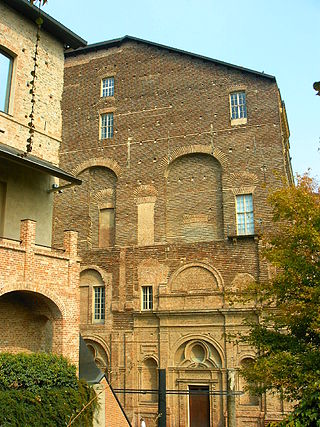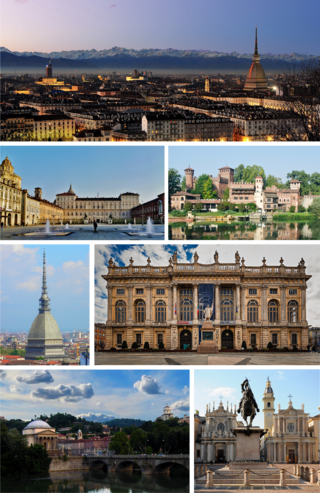Andrea Bruno | |
|---|---|
 | |
| Born | 11 January 1931 |
| Occupation | architect |
Andrea Bruno (born 11 January 1931 in Turin) is an Italian architect who specializes in conserving historic sites and museums.
Andrea Bruno | |
|---|---|
 | |
| Born | 11 January 1931 |
| Occupation | architect |
Andrea Bruno (born 11 January 1931 in Turin) is an Italian architect who specializes in conserving historic sites and museums.
Bruno completed his studies at the Architectural Faculty of the Istituto tecnico in Turin in 1956. He specialized in the field of architectural conservation of historic buildings, museums and public sites. Among the projects led by Bruno are the Castle of Rivoli, [1] Bagrati Cathedral, the Museum of Modern Art in Rivoli, the Faculty of Economics at the University of Turin, the Brigittines Theatre in Belgium and Château de Lichtenberg in France.
Bruno has been a consultant for UNESCO since 1974 in several missions in the Middle East and in Europe. [2]

The Residences of the Royal House of Savoy are a group of buildings in Turin and the Metropolitan City of Turin, in Piedmont. It was added to the UNESCO World Heritage Sites list in 1997.

Bruno Zevi was an Italian architect, historian, professor, curator, author, and editor. Zevi was a vocal critic of "classicizing" modern architecture and postmodernism.

The Castle of Rivoli is a former Residence of the Royal House of Savoy in Rivoli. It is currently home to the Castello di Rivoli – Museo d'Arte Contemporanea, the museum of contemporary art of Turin.

The Valentino Castle is a historic building in the northwestern Italian city of Turin. It is located in Parco del Valentino, and is the seat of the Architecture Faculty of the Polytechnic University of Turin. It is one of the Residences of the Royal House of Savoy included in the list of UNESCO World Heritage Sites in 1997.

Turin is a city and an important business and cultural centre in Northern Italy. It is the capital city of Piedmont and of the Metropolitan City of Turin, and was the first Italian capital from 1861 to 1865. The city is mainly on the western bank of the Po River, below its Susa Valley, and is surrounded by the western Alpine arch and Superga Hill. The population of the city proper is 847,287 while the population of the urban area is estimated by Eurostat to be 1.7 million inhabitants. The Turin metropolitan area is estimated by the OECD to have a population of 2.2 million.
Francesco Poli is an Italian art critic and curator. He teaches History of Contemporary Art at the Academy of Fine Arts of Brera. He is also "chargé de cours" at University of Paris 8 and teaches Art and Communication at the University of Turin.

Antonio del Massaro da Viterbo, or Antonio da Viterbo, nicknamed il Pastura was an Italian painter.
The Heating plant and main controls cabin is a technical facilities building in Firenze Santa Maria Novella railway station designed by architect Angiolo Mazzoni in 1929. The complex is recognized as one of the masterpieces of Futurist architecture.
In 2000 Paolo Brescia and Tommaso Principi established the collective OBR to investigate new ways of contemporary living, creating a design network among Milan, London and New York. After working with Renzo Piano, Paolo and Tommaso have oriented the research of OBR towards the integration artifice-nature, to create sensitive architecture in perpetual change, stimulating the interaction between man and environment. The team of OBR develops its design activity through public-private social programs, promoting – through architecture – the sense of community and the individual identities. Today OBR is group open to different multidisciplinary contributors, cooperating with different universities, such as Accademia di Architettura di Mendrisio, Aalto University, Academy of Architecture of Mumbai and Mimar Sinan Fine Art University. Among the best known works by OBR are the Pythagoras Museum, the New Galleria Sabauda in Turin, the Milanofiori Residential Complex, the Children Hospital in Parma, the Galliera Hospital in Genoa, the Lido of Genoa, the Ex Cinema Roma, the Triennale di Milano Terrace. The under construction projects by OBR include the Lehariya Cluster in Jaipur, the Jafza Traders Market in Dubai and the Multiuse Complex Ahmad Qasir in Teheran. OBR's projects have been featured in Venice Biennale of Architecture, Royal Institute of British Architects in London, Bienal de Arquitetura of Brasilia, MAXXI in Rome and Triennale di Milano. OBR has been awarded with the AR Award for Emerging Architecture at RIBA, the Plusform under 40, the Urbanpromo at the 11° Biennale di Venezia, the honourable mention for the Medaglia d'Oro all'Architettura Italiana, the Europe 40 Under 40 in Madrid, the Leaf Award overall winner in London, the WAN Residential Award, the Building Healthcare Award, the Inarch Award for Italian Architecture and the American Architecture Prize in New York. Since 2004 OBR has been evolving its design parameters according to the environmental and energy certification LEED and since 2009 OBR is partner of the GBC.

The Church of Santa Maria al Monte dei Cappuccini is a late-Renaissance-style church on a hill overlooking the River Po just south of the bridge of Piazza Vittorio Veneto in Turin, Italy. It was built for the Capuchin Order; construction began in 1583, and was completed in 1656. The original design was by Ascanio Vitozzi, but was completed by Giacomo Soldati.
Francesco Aprile, was an Italian sculptor and stucco artist, born in what is now Switzerland, and mainly active in Turin, the Duchy of Savoy, but also Rome.
The following is a timeline of the history of the city of Turin, Piedmont, Italy.
Paolo Brescia is an Italian architect and founder of OBR Open Building Research. He graduated with a degree in architecture from the Politecnico di Milano in 1996 and had his academic fellowship at Architectural Association in London. After working with Renzo Piano, he founded in 2000 OBR with Tommaso Principi to investigate new ways of contemporary living, creating a design network among Milan, London, Mumbai and New York. He combines his professional experience with the academic world as guest lecturer in several athenaeums, such as Accademia di Architettura di Mendrisio, Kent State University, Aalto University, University of Oulu, Academy of Architecture of Mumbai, College of Architecture of Pune, Mimar Sinan Fine Art University, Hacettepe University, Florida International University in Miami. He was university professor in charge at Politecnico di Milano (2004-2005) and University of Genoa (2013-2015). With OBR his projects have been featured in international exhibitions, including at X Biennale di Architettura in Venice 2006; RIBA Royal Institute of British Architects in London 2007; V Bienal de Arquitetura in Brasilia 2007; XI Bienal Internacional de Arquitectura in Buenos Aires 2007; AR Award Exhibition in Berlin 2008; China International Architectural Expo in Beijing 2009; International Expo in Shangai 2010; UIA 24th World Congress of Architecture in Tokyo 2011; Energy at MAXXI in Rome 2013; Italy Now in Bogotá 2014; Small Utopias in Johannesburg 2014; XIV Biennale di Architettura in Venice 2014; Triennale di Milano in Milan 2015 and Cooper Hewitt Smithsonian Design Museum in New York 2016.
Angelo Torricelli is an Italian architect.
Andrea Della Corte was an Italian musicologist and critic. Born in Naples on 5 April 1883, Della Corte studied law at the University of the native city, but was self-taught in music. After some short experiences in Neapolitan papers, he moved to Turin, where he was music critic for La Stampa from 1919 to May 1967. He brought the music journalism in Italy to a level of «professionalism hitherto unknown». In Turin, Della Corte also taught history of music, both at the Conservatory (1926–53) and at the University (1939–53).

Eugenio Gentili Tedeschi (1916-2005) was an Italian architect, designer, teacher and writer active in Italian building and product design from the 1940s until his death in 2005. Through his popular lectures while professor of design at Milan Politecnico and through his numerous books, he influenced many of the designers and architects working in Italy and abroad today. The United States Holocaust Memorial Museum and the Jewish Partisan Educational Foundation have recognized Gentili for his actions in the Italian Resistance in the Val d'Aosta during World War 2. His architectural legacy in the form of buildings can be seen in Milan and elsewhere in Italy today.

Sebastiano Giuseppe Locati was an Italian architect. He became famous at the turn of the twentieth century for his efforts in designing structures in eclectic and Art Nouveau styles.
Nicola De Maria is an Italian painter living and working in Torino, Italy. De Maria is known for his abstract figurative works, which have been characterized as lyrical and colourful.

The Sicilian Renaissance forms part of the wider currents of scholarly and artistic development known as the Italian Renaissance. Spreading from the movement's main centres in Florence, Rome and Naples, when Renaissance Classicism reached Sicily it fused with influences from local late medieval and International Gothic art and Flemish painting to form a distinctive hybrid. The 1460s is usually identified as the start of the development of this distinctive Renaissance on the island, marked by the presence of Antonello da Messina, Francesco Laurana and Domenico Gagini, all three of whom influenced each other, sometimes basing their studios in the same city at the same time.